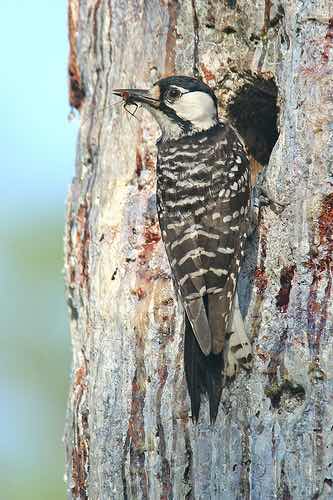Since the weather has gotten somewhat cooler here and the biting bugs have backed off a bit, we’ve been enjoying a return to the Great Outdoors. One morning last week we meandered along the Alligator Pond Trail in a longleaf pine forest, a tree that once covered 90 million acres of forest from Virginia to Florida. The longleaf was gradually replaced by the growing lumber industry with the faster-growing and more profitable yellow pine. In the name of progress, the robin-sized Red-cockaded woodpecker that depended on the longleaf nearly became extinct by the 1970s.
In some protected forests the longleaf pines have been reintroduced. They are beautiful trees with soft, fragrant needles up to 18 inches long!
We have been curious about the trees we see that have a wide band of white paint around them. We recently learned that the Forest Service marks trees to indicate evidence of Red-cockaded woodpecker activity.
On this hike we were rewarded with the close-up sight of not only a white-banded tree, but the presence of an artificial nesting box inserted into the tree trunk.
You see, before 1989 the Francis Marion National Forest (where we spend a lot of time enjoying the woods) had the densest naturally increasing population of red-cockaded woodpeckers in the country, about 475 of the endangered birds. Then, in 1989 Hurricane Hugo flattened the pine forests of coastal South Carolina and killed more than half the birds.
As the trees have been replanted, the Forest Service has worked to bring the birds back. A tree has to reach 80 feet tall before it is suitable for nesting, and then it takes the birds two to six years to make a nesting cavity in the heartwood. They are what is called “cooperative breeders,” meaning that the birds in a group work together to support a nesting pair. The parents, plus other non-breeding birds, work together to feed the young and maintain one nest cavity. Each group has a territory of about 125 acres of forest.
The artificial nesting boxes, about 10x25x6 cm, are made of cedar and placed in a manmade hole carved out in a live tree.
Several thousand boxes have been placed in the forests here and have allowed the birds to make a comeback, from approximately 200 in 1989 to 515 family clusters counted in August of this year.
You’re probably wondering what the birds look like that this fuss is all about. I wish I had a photo of my own to show you but, despite spending lots of time looking for them, we have not been able to see a single one let alone photograph it.
 This is a photo from the U.S. Fish and Wildlife Service. You might be wondering where its “red cockade” is. Well, the female doesn’t have one at all and the male’s is seldom visible. If we ever manage to see one, you’ll be the first to know!
This is a photo from the U.S. Fish and Wildlife Service. You might be wondering where its “red cockade” is. Well, the female doesn’t have one at all and the male’s is seldom visible. If we ever manage to see one, you’ll be the first to know!